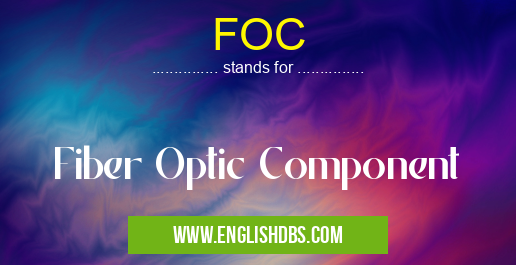What does FOC mean in UNCLASSIFIED
FOC (Fiber Optic Component) is a vital element in fiber optic communication systems, enabling the transmission of data over long distances with high bandwidth and low loss.

FOC meaning in Unclassified in Miscellaneous
FOC mostly used in an acronym Unclassified in Category Miscellaneous that means Fiber Optic Component
Shorthand: FOC,
Full Form: Fiber Optic Component
For more information of "Fiber Optic Component", see the section below.
What is FOC?
FOC refers to any device or component that is specifically designed for use in fiber optic systems. These components play crucial roles in transmitting, receiving, manipulating, and terminating optical signals in fiber optic networks.
Types of FOCs
FOCs encompass a wide range of devices, including:
- Optical Transceivers: Convert electrical signals to optical signals and vice versa.
- Optical Amplifiers: Boost the signal strength over long distances.
- Optical Multiplexers: Combine multiple optical signals onto a single fiber.
- Optical Demultiplexers: Separate multiple optical signals from a single fiber.
- Optical Attenuators: Reduce the intensity of optical signals.
- Optical Isolators: Prevent reflections and interference in optical signals.
- Optical Switches: Control the flow of optical signals in a network.
- Optical Connectors: Join and terminate fiber optic cables.
Importance of FOCs
FOCs are essential for the efficient operation of fiber optic networks due to their:
- High Bandwidth: Support transmission of large amounts of data at high speeds.
- Low Loss: Minimize signal degradation over long distances.
- EMI Immunity: Immune to electromagnetic interference.
- Compact Size: Enable high-density packaging in network equipment.
- Flexibility: Allow for easy deployment in various network topologies.
Essential Questions and Answers on Fiber Optic Component in "MISCELLANEOUS»UNFILED"
What is a Fiber Optic Component (FOC)?
A Fiber Optic Component (FOC) is a device that is used in fiber optic communication systems to perform a specific function. FOCs can be used to transmit, receive, or modify optical signals. They are typically made of glass or plastic and are designed to operate at specific wavelengths of light.
What are the different types of FOCs?
There are many different types of FOCs, each with its own specific function. Some of the most common types of FOCs include:
- Fiber optic cables: These are used to transmit optical signals over long distances.
- Connectors: These are used to connect fiber optic cables to each other or to other devices.
- Splices: These are used to join two fiber optic cables together.
- Attenuators: These are used to reduce the power of an optical signal.
- Amplifiers: These are used to increase the power of an optical signal.
- Multiplexers: These are used to combine multiple optical signals into a single signal.
- Demultiplexers: These are used to separate a single optical signal into multiple signals.
How do FOCs work?
FOCs work by transmitting light signals through a fiber optic cable. The light signals are typically modulated with data, which is then transmitted over the fiber optic cable to the receiving device. The receiving device then demodulates the light signals and recovers the data.
What are the advantages of using FOCs?
FOCs offer a number of advantages over traditional copper cables, including:
- Higher bandwidth: FOCs can transmit data at much higher speeds than copper cables.
- Lower loss: FOCs experience less signal loss than copper cables, which makes them ideal for long-distance applications.
- Immunity to electromagnetic interference: FOCs are not affected by electromagnetic interference, which makes them ideal for use in noisy environments.
- Smaller size and weight: FOCs are much smaller and lighter than copper cables, which makes them easier to install and maintain.
What are the disadvantages of using FOCs?
FOCs also have some disadvantages, including:
- Higher cost: FOCs are more expensive than copper cables.
- Fragility: FOCs are more fragile than copper cables and can be easily damaged if they are not properly installed and maintained.
- Limited distance: FOCs have a limited transmission distance, which makes them unsuitable for very long-distance applications.
Final Words: Fiber optic components (FOCs) are indispensable in today's communication infrastructure, enabling high-speed, long-distance data transmission. With their advanced capabilities and diverse applications, FOCs continue to drive innovation in fiber optic networks.
FOC also stands for: |
|
| All stands for FOC |
